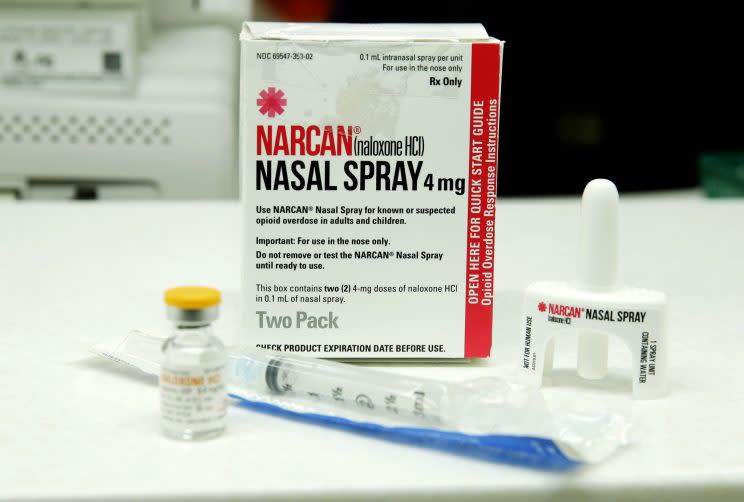On the way to colleges: 40,000 doses of opioid-blocker naloxone, the ‘Lazarus drug’

As the U.S. government and health care providers grapple with the exploding rates of opioid abuse across the country, the Clinton Foundation has expanded its partnership with Adapt Pharma, maker of Narcan nasal spray, by donating 40,000 doses of the opioid overdose reversal drug to colleges and universities throughout the United States. Narcan, a brand of the generic drug naloxone, is used for the emergency treatment of known or suspected opioid overdose.
“We know that most overdose deaths don’t happen in hospitals, which is why we’re working with Adapt Pharma, the American School Nurses Association, and a number of other partners to make FDA-approved naloxone Narcan nasal spray available in high schools, colleges and universities, and other community centers where people already are,” said Alex Chan, director of National Health for the Clinton Health Matters Initiative, an initiative of the Clinton Foundation.
“President Bill Clinton has spoken about young men he knew who had suffered from accidental drug overdoses, and it prompted the Clinton Foundation to look closely at the issue of prescription drug misuse, and identify what we might be able to do,” Chan added.
Hillary Clinton also expressed her passion for combating the crisis. During her presidential campaign last year, she laid out a detailed plan for tackling the epidemic, vowing to put $10 billion over 10 years toward a coalition she called the “Initiative to Combat America’s Deadly Epidemic of Drug and Alcohol Addiction.” It was an exhaustive plan in which, among many other details, Clinton promised to require better training and monitoring for opioid prescriptions, improve barriers to care to create more preventive efforts and treatment programs, reform the criminal justice system to avoid putting drug users in prison, and offer easier access to naloxone for first responders.
Among the universities receiving naloxone from the new partnership are 53 member schools in the Association of Independent Colleges and Universities of Ohio. Ohio is a state with one of the highest rates of death due to prescription and illicit overdoses in the country.
“This initiative further equips colleges and universities to take a proactive approach to the growing opioid epidemic,” Robert Helmer, president of Ohio’s Baldwin Wallace University, said in a statement.
Patented in 1961 and approved by the FDA in 1971, naloxone is not addictive and is most commonly administered intravenously, though a more user-friendly nasal spray is now available. Some have called naloxone the “Lazarus drug,” because it can feel like the person administering it is raising someone from the dead.
As the opioid addiction crisis has exploded throughout the U.S., experts across the country have been working to make naloxone more readily available to the public — members of law enforcement, firefighters, first responders, departments of health, local school districts, colleges, community-based organizations, and homeless shelters. “No area of this country is safe from this epidemic,” said Jennifer Plumb, MD, an assistant professor of pediatrics at the University of Utah and founder of Utah Naloxone.
While the FDA technically requires a prescription for the drug, the majority of U.S. states now allow a person to purchase naloxone from a pharmacist without one. Over the past year, CVS and Walgreens — among other pharmacy chains — have also expanded over-the-counter availability of the ocerdose reversal drug.
Some critics worry that naloxone is a Band-Aid for a complex problem, calling the drug’s accessibility an excuse for opioid users to continue consuming it. But most experts, while trying to get a handle on the crisis, praise the expanded efforts, especially on the heels of a CDC review that found heroin-related overdose deaths have more than quadrupled since 2010. “Unless people are alive, they can’t recover,” said Thom Duddy, communications director of Adapt Pharma.
Opioids — prescription medications and street drugs such as heroin — now are the leading cause of accidental death in the U.S. They killed more than 33,000 people in 2015, more than any year on record, according to the CDC. About half of the deaths involved prescription opioids. That number surpasses HIV/AIDS deaths in 1995, at the peak of the AIDS epidemic. While the U.S. makes up about 5 percent of the global population, it consumes more than 80 percent of the opioids in the world.
“Naloxone isn’t going to cure this crisis, but until we get a better grip on getting people the help they need, it’s acting as the proverbial fire extinguisher,” said Plumb. “Having greater access will also inspire a lot of dialogue in school about drug use as well.”
The Clinton Foundation doesn’t have formal partnerships with rehabilitation or treatment centers, but it does collaborate with such centers and health agencies to ensure that individuals have access to support services when seeking treatment for addiction.
Chan of the Clinton Foundation said it is working to “make sure everyone has a seat at the table” by working toward a multidimensional approach to figuring out “how to advance the solutions overall.”
Read more from Yahoo News:
‘Judge sitting on an island’: Sessions dismisses Hawaii court’s travel ban ruling
Government shutdown deadline looms as Republicans return to Washington
Trump bemoans ‘ridiculous standard’ of judging presidents by first 100 days
Photos: A mother seeks cancer treatment for her son during Venezuela’s health crisis



